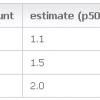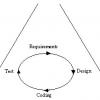|
|
Estimation Roller Coaster The estimation roller coaster can provide an unwelcome burst of adrenaline to an otherwise smoothly running project. Adapting estimates over time lets you plan and deliver value at a sustainable pace.
|
|
 |
Software Project Estimation Tired of guesstimating your estimation process just to create a completion date management will accept? Jonathan Kohl takes the guess work out of estimations by focusing on uncertainties. It may sound counterintuitive, but the idea is to focus on the fact that all projects face unforeseen delays. The rigorous estimation process Jonathan describes here provides your team a way that ensures enough time is scheduled for development and a date for completion management can agree upon.
|
|
|
|
An Agile Approach to Scheduling When we schedule too many variables, things start to slip and soon the schedule is out the window. Paying attention to your project's constraints can help you set realistic scheduling goals that you will actually be able to stick to.
|
|
|
|
Less Is More Twentieth Century architect Ludwig Mies van der Rohe, who coined the dictum, "less is more," is known for his simple designs. Interestingly, this concept has proven true time and time again in the software industry. In this column, Linda Hayes explains reasons why simplifying your team when it comes to quantity is so vital and shares some surprising statistics on how team size can affect quality.
|
|
|
|
Effort Estimating for Test Automation Projects The author shares lessons learned in estimating test automation efforts, including the effort to idendity candidates for test automation andfactors that affects test automation estimation.
|
|
|
|
The Goldilocks Parable: How Much Process Is Just Right Getting process improvement "just right" is difficult. Go too far in the definition of processes, and it really does get too hot, with the heat coming from the people trying to use the processes. On the other hand process definitions that are too short to contain anything of value will leave users in the cold, and then there will be no improvement in the organization. Ed Weller states that a useful process improvement activity develops a set of process artifacts that meets the needs of the user. This helps the organization capture "tribal lore" and cast it into a set of process definitions that eliminates waste and improves time-to-market.
|
|
 |
Suffering for Success One of the most valuable services a QA group provides is preventing failure. Ironically if the group succeeds at this, QA might find themselves unpopular or out of a job. Linda Hayes reveals how typical methods of measuring success can actually cause failure. Especially if success is achieved at the loser's expense.
|
|
 |
The Estimation Fallacy in IT Software Development Despite the fact that iterative approaches to software development are increasingly used, most of the people paying for IT software developmet have an expectation that we should be able to tell them—before coding starts—"what's it going to do, what's it going to cost, and when's it going to be ready?" This article exlains why that's an unattainable expectation and corrects the misleading "product-lifecycle-model" for estimating.
|
|
|
|
How to Preview User Satisfaction before Your Release Why wait to discover how your users will react to your system when there are ways to measure such things during development? This column describes a simple tool to develop visibility into customer satisfaction. Learn how you can begin to manage expectations so that neither you nor the customer has an unpleasant surprise on release day.
|
|
 |
Calculating the Economics of Software Inspections Without return on investment (ROI) calculations for the software inspections process, you cannot know the true benefit of those inspections. In this article, Ed Weller makes some assumptions about the cost of inspections and tries to estimate the savings from reduced test cost. He also provides a spreadsheet for doing "what-if" analysis of different savings based on inspection effectiveness, and how much defect removal in test might cost.
|
|

